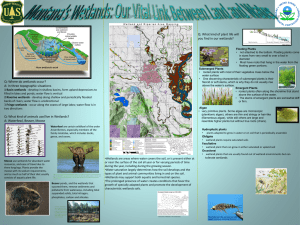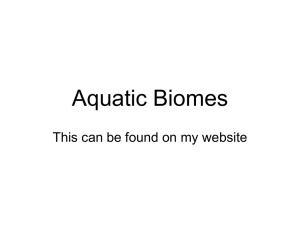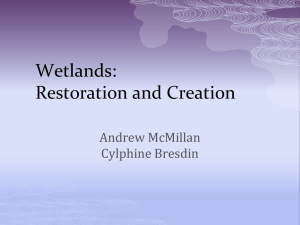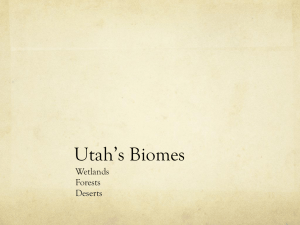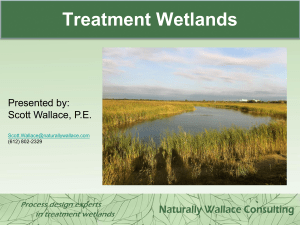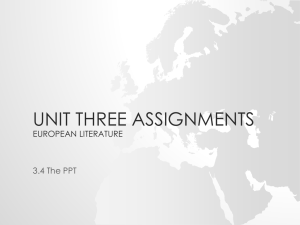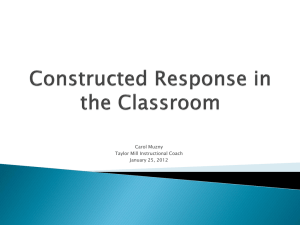Constructed Wetlands
advertisement
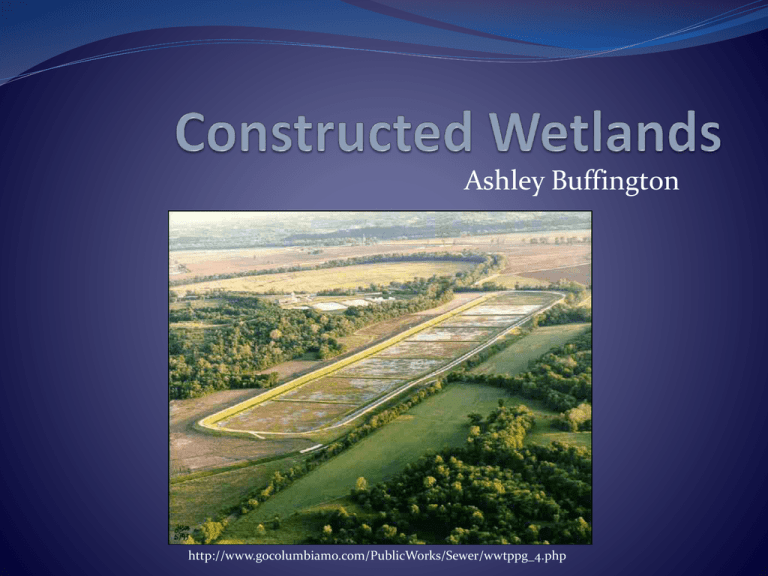
Ashley Buffington http://www.gocolumbiamo.com/PublicWorks/Sewer/wwtppg_4.php Constructed Wetlands Created to treat variety of wastewaters First experiments carried out by Käthe Siedel in Germany in 1952 Classified into four categories: Free-water surface flow (FWS) Sub-surface flow (SSF) Hybrid systems Zero discharge systems Constructed Wetlands: Free-Water Surface Flow Basins with shallow waters and substrate to support rooted vegetation First FWS CW created in Ijssel Lake Polder Authority in Flevoland in the Netherlands in 1967 FWS CW systems with: Free-floating macrophytes Floating-leaved macrophytes Submerged macrophytes Emergent macrophytes http://sudied.blogspot.com/2010/04/water-and-city.html Constructed Wetlands: Sub-Surface Flow Contain underground flow of wastewater through substrate Can be beneficial in areas where wildlife is discouraged http://sudied.blogspot.com/2010/04/water-and-city.html Types of SSF CWs: Horizontal Flow (HF) Vertical Flow (VF) Down flow Up flow http://sudied.blogspot.com/2010/04/water-and-city.html Constructed Wetlands: Hybrid Systems Result from combining different types of CWs Advantages and disadvantages of CWs combined to complement each other Higher treatment effect accomplished http://www.iridra.com/eng/cw_ibr.htm Constructed Wetlands: Zero-discharge Systems Developed in Denmark for sewage disposal in rural areas Consists of basins lined with HDPE, filled with soil and planted with willows Removal of water via evapotranspiration Harvested regularly http://www.pilerensning.dk/english/index.php?option=com_content&view=article&id=53&Itemid=56&lang=da Constructed Wetlands: Advantages Cost 50-90% less than conventional wastewater treatment systems Require little external energy input Rely on solar energy to operate More sustainable compared to conventional treatment plants Improve air quality and help fight global warming Provide green space, habitat for wildlife, recreational and educational opportunities Constructed Wetlands: Limitations Require large areas of land Require long periods for vegetation to establish for optimal treatment efficiencies Potentially susceptible to influences such as storms, wind, and floods Steep topography and high water table limit these systems Expensive to implement Constructed Wetlands: Costs CA = $196,336A−0.511 Where CA is the capital cost of wetland construction per unit area ($ha−1 ) and A is the wetland area (ha) 1-ha wetland ≈ $200,000 10-ha wetland ≈ $60,000 per ha 100-ha wetland≈ $19,000 per ha SSF CWs are more expensive than FWS CWs Initial cost ≈ $388,000 (SSF); ≈ $58,000 (FWS) Constructed Wetlands: Operation and Maintenance Life expectancy between 30-50 years General maintenance tasks: Removing debris/litter Monitoring depth of sediments Checking for channelization Identifying any damage from vandalism Inspecting inlet and outlet Operation and maintenance cost ≈ $85,000 annually Estimated for a 175 ha wetland Includes approx. $50,000 for personnel Costs range from $5,000-$50,000 for smaller wetlands Case Study: Apache Powder Superfund Site Cochise County, Arizona Approx. 9 mi² and 1,100 acres owned by Apache Nitrogen Products (ANP) Began manufacturing industrial chemicals and explosives in 1922 Produced liquid and solid wastes disposed on ANP property Investigated in 1987 Soils showed high levels of heavy metals and arsenic Groundwater showed high levels of contamination as well Case Study: Multi-celled wetland system used Apache Powder Superfund Site Cochise County, Arizona Groundwater pumped from shallow aquifer to first cell Nitrate levels in groundwater entering first cell were approx. 250 ppm Nitrate levels leaving fifth cell were approx. 10 ppm Can treat 200 gallons water per minute Water stays about 5 days in system Costs savings estimated to be $15 million References Federico, R., and J. Kandasamy. "Operation and Maintenance of Wetlands." Constructed Wetlands. Ed. Jaya Kandasamy and Saravanamuthu Vigneswaran. New York: Nova Science, 2008. 57-73. Print. Ghanem, P. and B. Simpson. "Design and Construction of Constructed Wetlands." Constructed Wetlands. Ed. Jaya Kandasamy and Saravanamuthu Vigneswaran. New York: Nova Science, 2008. 27-56. Print. Lorion, Renee. "Constructed Wetlands: Passive Systems for Wastewater Treatment." U.S. Environmental Protection Agency, Aug. 2001. Web. 20 Mar. 2011. <http://permanent.access.gpo.gov/websites/epagov/www.epa.gov/swertio1/download/remed/constructed_wetlands.pdf>. Mitsch, William J., and James G. Gosselink. Wetlands. 4th ed. Hoboken, NJ: Wiley, 2007. Print. Moat, G., B. Simpson, P. Ghanem, J. Kandasamy, and S. Vigneswaran. "Constructed Wetlands: Classification, Functions, and Treatment." Constructed Wetlands. Ed. Jaya Kandasamy and Saravanamuthu Vigneswaran. New York: Nova Science, 2008. 1-26. Print. "Region 9: Superfund." Environmental Protection Agency, 14 July 2010. Web. 19 Apr. 2011. <http://yosemite.epa.gov/r9/sfund/r9sfdocw.nsf/vwsoalphabetic/Apache+Powder+Company?OpenDocument> Vymazal, Jan, and Lenka Kröpfelová. Wastewater Treatment in Constructed Wetlands with Horizontal Sub-surface Flow. Berlin: Springer Netherland, 2008. Print. Vymazal, Jan, Margaret Greenway, Karin Tonderski, Hans Brix, and Ulo Mander. "Constructed Wetlands for Wastewater Treatment." Wetlands and Natural Resource Management. Ed. J. T. A. Verhoeven, B. Beltman, R. Bobblink, and D. F. Whigman. Vol. 190. Berlin: Springer, 2006. 69-96. Print. Ecological Studies. Questions



